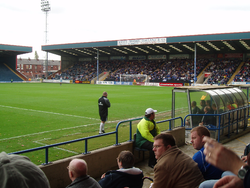Rochdale Hornets
Their main local rivals are Oldham, Salford Red Devils, Swinton Lions, Halifax and the Huddersfield Giants.
Hornets had an open door approach to membership and were able to insist on gate money as they played on an enclosed field.
In June 1879, Rochdale Rovers threw in their lot with the Hornets, and it was in this year that the club first adopted the white jersey.
Hornets made a poor start under the new regime and finished bottom of the league table, for a good number of years they lost many more matches than they won.
Between the 7–9 March 1901, a three-day bazaar was held at the town hall where around £1,000 was raised to help pay for the club's debts.
Rochdale Hornets then refused to travel to Dewsbury on 1 October 1904 on account of a smallpox outbreak, and were subsequently fined £20.
Hornets played six games in a fortnight before falling to their biggest ever defeat 79–2 at the hands of Hull FC.
Hornets won the Northern Union Challenge Cup in 1922 by beating Hull 10–9 at Headingley, Leeds.
Owing to a financial crisis in 1931, the Athletic Ground was offered for sale and all the players put on the transfer list.
In 1947 and 1958, Rochdale Hornets made it to the semi-finals of the Challenge Cup, but both times Wigan ended their hopes of a Wembley Final.
On 24 October 1953, Hornets' second row Ralph Slater was fatally injured in an A-team game at the Athletic Grounds against Oldham A. Rochdale's highest attendance in a league match was set on Saturday, 16 October 1954 when Hornets lost 4–18 to local rivals Oldham in front of 19,654 spectators.
Rochdale Hornets brought in a Fijian contingent in the early 1960s, starting with Orisi Dawai and Josefa Levula in 1961 and, later Apisai Toga.
[4][5] In 1965, Hornets appeared in the final of the Lancashire County Cup when a 19,000 crowd saw them lose to Warrington at Knowsley Road, St. Helens.
On 9 May 1996, Rochdale sacked their coach, Steve Gibson, after taking just one point from their first six games of the First Division season.
A ten-match losing sequence was ended as Hornets won at Featherstone Rovers in Fox's first match in charge.
On 13 March 2005, Hornets set an all-time Rugby League record when they defeated the amateur side Illingworth 120–4 in the Challenge Cup.
Bobbie Goulding was appointed as Rochdale Hornets coach for the second time in September 2007 and relieved of his duties in May 2008 after a run of six consecutive losses.
[7] On 13 January 2009, shareholders voted to put Rochdale Hornets into administration after debts ordered by HM Revenue and Customs accumulated £55,000.
[8] An Industrial and Provident Society (a co-operative) was created and recognised by the Rugby Football League, and the Hornets were re-founded.
Darren Shaw departed the club at the end of the 2009 season and was replaced by ex St Helens player John Stankevitch in early November 2009.
Stankevitch signed a new contract in July 2010 in preparation for the 2011 and 2012 seasons, and began the club's re-emergence with the recontracting of the majority of his squad.
He led Hornets to their first trophy in 91 years when they won the Kingstone Press Championship 1 play-off final defeating local rivals Oldham at Leigh Sports Village.
Ian Talbot stood down as head coach at Hornets at the end of the 2015 season to take up a position at St. Helens.
Having successfully retained Championship status in (2017) Rochdale Hornets again avoided relegation in (2018) due to the lifeline of a league restructure.
The club sadly struggled to sustain its position in the second tier winning just one league game all season and finally succumbed to relegation at the end of a turbulent (2019).
CEO Steve Kerr who had been mandated to seek investment approached former Swinton Lions Chairman Andy Mazey.
Following a series of talks Andy headed up a consortium to include club president Paul Ormerod, and his former Swinton associates Tony Sheridan, Richard Hayes and Peter Smith.
A proposal to take over the club and convert it back into private ownership was tabled and a special resolution passed on December 23, 2019, to change the business model after a number of presentations and supporter engagement sessions.
Hornets borrowed £3,000 from the Rugby Football League in 1954 to build a new covered outer boundary wall and new turnstiles for the main entrance and Waithlands.
The highest attendance for a league match was set on Saturday 16 October 1954, Hornets lost 4–18 to local rivals Oldham in front of 19,654 spectators.

